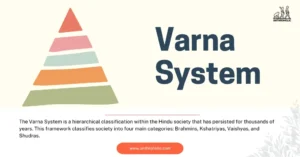AI Answer Evaluation Platform Live Now. Try Free Answer Evaluation Now
Types of Kinship
Kinship is a central concept in anthropology, shaping our understanding of social structures and relationships in human societies. It influences many facets of human behavior, from marriage practices to political organization and economic systems [1]. Kinship is essentially a set of symbolic and practical frameworks, providing individuals with a sense of identity and mutual obligation within a group [2].

The Role of Kinship in Different Societies
Across different societies, the significance and interpretation of kinship can vary. In many Western societies, for example, kinship tends to be based on consanguinity or biological ties and legal bonds like marriage. However, in many other societies, kinship can extend beyond mere blood or legal ties to include broader communal and spiritual ties.
Defining Kinship
Biological and Affinal Ties: Two Broad Categories
Broadly, kinship ties can be classified into two main categories: consanguineal or biological ties, and affinal or marriage ties. Consanguineal ties refer to bonds formed by common ancestry, such as the relationship between parents and children or between siblings. On the other hand, affinal ties are those formed through marriage, such as the relationship between a husband and wife, or between a person and their in-laws [3].
Understanding the Concept of Fictive Kinship
Fictive kinship is another form of kinship which is neither consanguineal nor affinal. These ties are not based on blood or marriage but are nonetheless considered kinship relationships. This form of kinship is common in many societies where unrelated individuals can become classified as ‘kin’ through certain rituals, shared experiences, or mutual obligations.
The Basic Elements of Kinship
Descent: Unilineal, Bilinary, and Ambilineal
Descent is one of the main organizing principles of kinship. Unilineal descent traces lineage through one gender line only, either patrilineal (through the father) or matrilineal (through the mother). Bilateral or cognatic descent recognizes kinship ties through both male and female lines, typical in many Western societies. Ambilineal descent allows individuals to choose to trace their descent through either the male or female line.
Alliance: Exogamy and Endogamy
Marriage rules form the second main element of kinship, typically classified as exogamy and endogamy. Exogamy mandates marriage outside a certain social group or category, often used to create alliances between different groups. Conversely, endogamy requires marriage within a specific group, reinforcing social boundaries and maintaining group cohesion.
Major Types of Kinship Systems
Eskimo Kinship System
The Eskimo kinship system, prevalent in many Western societies, prioritizes the nuclear family. Siblings and parents are differentiated from other types of relatives. Beyond the nuclear family, distinctions are not made based on gender or generation, with all aunts/uncles and cousins referred to with the same terms.
Hawaiian Kinship System
The Hawaiian system is the most classificatory, with all relatives of the same generation referred to by the same term, regardless of the side of the family they belong to. It emphasizes generational differences, with no distinction between blood relatives and in-laws within the same generation.
Iroquois Kinship System
Iroquois kinship is a type of bifurcate merging system, differentiating between parallel and cross-cousins. Parallel cousins (children of the father’s brother or the mother’s sister) are classified with siblings, while cross-cousins (children of the father’s sister or the mother’s brother) are considered potential marriage partners.
Crow Kinship System
The Crow system is a matrilineal system, in which relatives on the mother’s side of the family are classified differently from those on the father’s side. It also follows a bifurcate merging pattern, differentiating parallel and cross-cousins, similar to the Iroquois system but in a matrilineal context.
Omaha Kinship System
The Omaha system is a patrilineal system that also differentiates between parallel and cross-cousins. This system is similar to the Crow system but is oriented toward the father’s lineage.
Sudanese Kinship System
The Sudanese system is the most descriptive. It has a separate designation for each specific type of relative, based on generation, lineage, gender, and the side of the family, making it one of the most complex kinship systems.
Case Studies: The Functioning of Different Kinship Systems
Case Study 1: Eskimo Kinship in Modern Inuit Societies
- The Eskimo kinship system is distinguished by its bilateral nature and its emphasis on the nuclear family. In modern Inuit societies, this kinship system plays a central role.
- While the nuclear family is the basic social unit, the larger kin group or ‘ilagiit’ is also significant, providing mutual support and cooperation especially in hunting and sharing food resources.
- It’s crucial to note that kinship in Inuit society extends beyond consanguinity and affinity to include social bonds as well, encompassing fostered children or relationships established through naming ceremonies.
- Modern challenges such as climate change and globalization have stressed these kinship structures, yet they remain resilient, adapting to maintain their social and cultural significance.
Case Study 2: Iroquois Kinship and the Role of Matrilineal Descent
- The Iroquois kinship system, characterized by a bifurcate merging pattern, continues to shape social structures among the Iroquois nations.
- The system is matrilineal, with clans being formed along female bloodlines.
- This matrilineal structure has historically played a critical role in determining political leadership, inheritance, and social responsibilities.
- Today, even amidst the pressures of modernization and cultural assimilation, this system maintains relevance.
- Kinship ties continue to influence social organization, land rights, and political structures.
- These enduring structures highlight the resilience of traditional kinship systems, even in the face of societal change.
The Role of Kinship in Social Structure
Kinship and Marriage
Kinship rules often determine eligible marriage partners. For example, some societies practice exogamy, marrying outside a particular group, while others practice endogamy, marrying within a group.
Kinship and Economic Structures
In many societies, kinship ties determine economic responsibilities and rights, such as inheritance rights or labor obligations. These can play a role in the division of resources and power within a community.
Kinship and Political Structures
Kinship can influence the distribution of political power, for instance, in societies with chiefly titles or leadership roles passing through specific kinship lines. It may also determine alliances and feuds in political interactions.
Kinship and Religion
Kinship often intertwines with religious practices, such as in ancestor worship where lineage determines religious obligations. Moreover, religious doctrines can influence kinship structures and marriage rules.
Modern Perspectives on Kinship
The Impact of Globalization and Modernization on Kinship Structures
Globalization and modernization have significantly influenced kinship structures. Mobility and migration, for instance, have led to dispersed kinship networks and the rise of transnational families. These changes challenge traditional kinship norms and necessitate new ways of maintaining kinship ties across geographical distances.
Transnational and Adoptive Kinship
Transnational kinship emerges from migration patterns, as families maintain relationships across national boundaries. Technology plays a key role in sustaining these long-distance relationships. Similarly, adoptive kinship ties formed through adoption also challenge traditional biological and marital bases for kinship. Adoption provides an avenue for creating families based on mutual consent and obligation, independent of biological ties.
Kinship in LGBTQ+ Communities
The recognition of LGBTQ+ families has broadened the concept of kinship beyond heteronormative structures. These families can be formed through various means, including adoption, assisted reproduction, and surrogacy. Moreover, the concept of ‘chosen family’ within the LGBTQ+ community highlights the significance of non-biological ties.
Assisted Reproductive Technologies and Kinship
Assisted reproductive technologies, such as in vitro fertilization and surrogacy, have reshaped notions of kinship by enabling new ways of childbearing. These technologies separate biological and social parenthood, raising anthropological questions about the nature of relatedness and the role of genetic ties in kinship.
Conclusion
Kinship systems, although diverse, play a crucial role in shaping social structure in different societies, influencing not only family and personal relationships but also broader societal mechanisms including economic, political, and religious systems. Understanding these systems enhances our understanding of human culture and societal organization.
References
[1] Keesing, R. M. (1998). Cultural anthropology: A contemporary perspective. Harcourt Brace College Publishers. https://archive.org/details/culturalanthropo0000kees_v3x7
[2] Carsten, J. (2004). After kinship. Cambridge University Press.
[3] Holy, L. (1996). Anthropological perspectives on kinship. Pluto Press.




